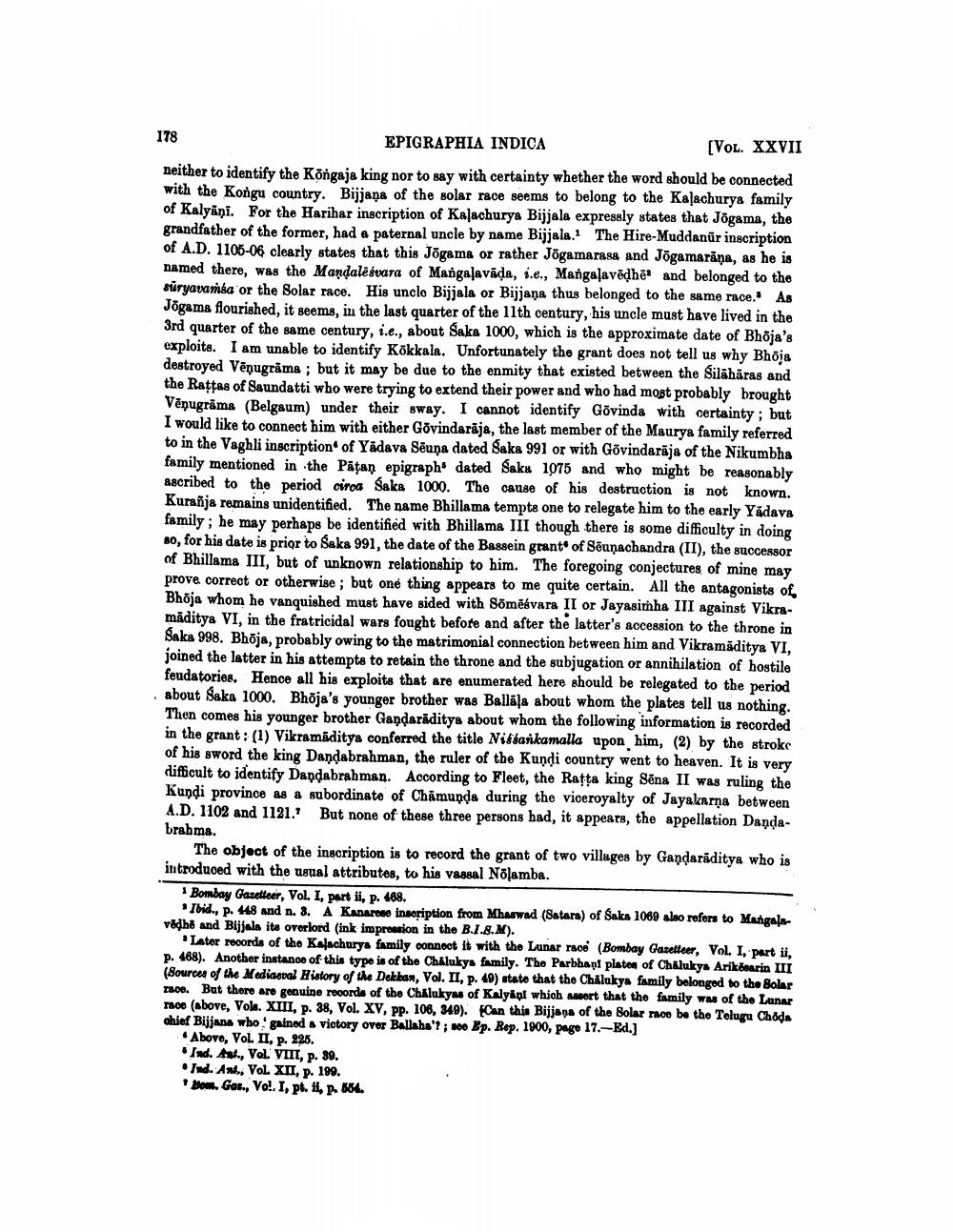________________
178
EPIGRAPHIA INDICA
(VOL. XXVII
neither to identify the Kõngaja king nor to say with certainty whether the word should be connected with the Kongu country. Bijjana of the solar race seems to belong to the Kalachurya family of Kalyani. For the Harihar inscription of Kalachurya Bijjala expressly states that Jögama, the grandfather of the former, had & paternal uncle by name Bijjala. The Hire-Muddanūr inscription of A.D. 1105-06 clearly states that this Jõgama or rather Jõgamarasa and Jõgamarāņa, as he is named there, was the Mandalësuara of Mangalavāda, i.e., Mangalavödhë' and belonged to the süryavansa or the Solar race. His unclo Bijjala or Bijjana thus belonged to the same race. As Jógama flourished, it seems, in the last quarter of the 11th century, his uncle must have lived in the 3rd quarter of the same century, i.e., about Saka 1000, which is the approximate date of Bhöja's exploits. I am unable to identify Kókkala. Unfortunately the grant does not tell us why Bhoja destroyed Vēnugråma; but it may be due to the enmity that existed between the Silähäras and the Rattas of Saundatti who were trying to extend their power and who had most probably brought Vēņugrima (Belgaum) under their sway. I cannot identify Govinda with certainty ; but I would like to connect him with either Govindaraja, the last member of the Maurya family referred to in the Vaghli inscription of Yadava Sēuņa dated Saka 991 or with Govindarāja of the Nikumbha family mentioned in the Pâtan epigraph' dated Saks 1075 and who might be reasonably ascribed to the period ciroa Saka 1000. The cause of his destruction is not known. Kurañja remains unidentified. The name Bhillama tempts one to relegate him to the early Yadava family; he may perhaps be identified with Bhillama III though there is some difficulty in doing Bo, for his date is prior to Saka 991, the date of the Bassein grant of Sēunachandra (II), the successor of Bhillama III, but of unknown relationship to him. The foregoing conjectures of mine may prove correct or otherwise ; but one thing appears to me quite certain. All the antagonists of Bhoja whom he vanquished must have sided with Sõmēsvara II or Jayasimha III against Vikramaditya VI, in the fratricidal wars fought before and after the latter's accession to the throne in Baka 998. Bhöja, probably owing to the matrimonial connection between him and Vikramaditya VI. joined the latter in his attempts to retain the throne and the subjugation or annihilation of hostile feudatories. Hence all his exploits that are enumerated here should be relegated to the period about Saka 1000. Bhõja's younger brother was Ballāļa about whom the plates tell us nothing. Then comes his younger brother Gandarāditya about whom the following information is recorded in the grant: (1) Vikramaditya conferred the title Nifbankamalla upon him, (2) by the stroke of his sword the king Dandabrahman, the ruler of the Kundi country went to heaven. It is very difficult to identify Dandabrahman. According to Fleet, the Ratta king Sēna II was ruling the Kundi province as a subordinate of Chamunda during the viceroyalty of Jayakarna between A.D. 1102 and 1121.' But none of these three persons had, it appears, the appellation Dandabrahma.
The object of the inscription is to record the grant of two villages by Gandarāditya who is introduoed with the usual attributes, to his vassal Nolamba.
Bombay Gazetteer, Vol. I, part ii, p. 468.
Ibid., p. 148 and n. 8. A Kanarono inseription from Mhaswad (Satara) of Saka 1089 slao refers to Mangala vedhë and Bijjala its overlord (ink impression in the B.1.8.M).
'Later records of the Kalachurya family connoot it with the Lunar race (Bombay Gazetteer, Vol. I, part ii, p. 468). Another instance of this type is of the Chilukys family. The Parbhani plates of Chalukya Arikësarin III (Sources of the Mediaeval History of the Dekban, Vol. II, p. 49) state that the Chalukya family belonged to the Solar race. But there are genuine rooorde of the Chalukyus of Kalyanl which bort that the family was of the Lunar race (above, Vols. XIII, p. 38, Vol. XV, pp. 106, 349). Can this Bijjana of the Solar race be the Telugu Choda chief Bijjana who gainod a victory over Ballaha'? ; 1 Ep. Rep. 1900, page 17.-Ed.)
Above, VOL II, p. 225. Ind. Ant., Vol. VIII, p. 39. Ind. AnVoL XII, p. 199. Hom. Gar., Vol. I, pt. 1, p. 654.




